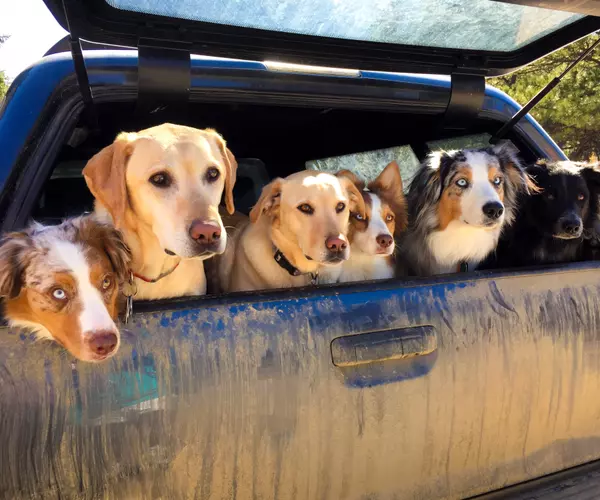Visit the Vet:
A pre-move check-up is crucial to ensure your pet is healthy and ready for the move. This visit is the perfect time to update any vaccinations, discuss anxiety or motion sickness medications if needed, and collect your pet's medical records. Ask your vet for recommendations on a new vet in your new area.
Update Identification:
Pets can get disoriented and lost during moves. Update your pet’s ID tags with your new address and a reliable contact number. If your pet is microchipped, ensure the registered information is current. This simple step can make a big difference in quickly reuniting with your pet should they wander off.
Familiarize Your Pet:
Introduce your pet to their carrier or moving crate well in advance. Start with short periods and gradually increase the time they spend in it. Make it a positive experience by including their favorite blanket or toys, and reward them for calm behavior. This familiarity can help reduce their anxiety on moving day.

Space Matters:
Evaluate homes with your pet in mind, ensuring there's enough indoor space for your pet to move around freely. A secure, fenced yard can provide a safe area for outdoor play but remember indoor space is just as important for your pet's comfort.
Neighborhood Walkability:
A neighborhood with accessible parks, trails, and sidewalks offers great opportunities for daily walks and exercise with your pet, enhancing their physical and mental well-being.
Safety First:
Inspect the new home and surrounding area for potential dangers to your pet, such as busy streets that could pose risks for pets who like to roam, or local wildlife that may be a threat. Ensure the home is equipped to keep your pet safe and secure.

Keep Routines:
Amid the chaos of packing and organizing, strive to keep your pet’s feeding, walking, and play routines as normal as possible. Consistency can provide a sense of security for your pet during this unsettling time.
Safe Zone:
Designate a quiet room or a familiar crate as a safe place for your pet on moving day. This area should be away from the hustle and bustle, equipped with their bed, toys, and water, where they can relax without getting stressed by the moving activity.
Familiar Items:
When packing your pet’s belongings, leave out their favorite items until the last moment. Once in the new home, set up their space with these familiar items immediately to help them feel more at ease and signify that this new place is also their home.

Moving Day: Ensuring a Smooth Transition
Secure Transportation:
Whether you’re moving by car or van, secure your pet using a crate, carrier, or seatbelt harness designed for pets. This not only keeps them safe but also prevents distractions while you’re driving.
Frequent Breaks:
On long journeys, stop every few hours to let your pet out (safely on a leash) to use the bathroom, stretch their legs, and drink water. These breaks are essential for their comfort and can help reduce anxiety.
Immediate Comfort:
Upon arriving, before you unpack anything else, set up a space for your pet with all their familiar items. This immediate gesture of comfort can help mitigate the stress of being in a new environment and help them adjust faster.

Explore Together:
Let your pet explore the new environment at their pace while keeping them on a leash or closely supervised. Offer treats and comforting words as they investigate their new surroundings to reinforce a positive association with the home.
Safety Proofing:
Walk through your new home with a critical eye for any pet hazards—secure loose wires, ensure windows have screens, and remove any plants that could be toxic to your pet. Taking these precautions can prevent accidents and ensure your pet’s safety.
Find Local Pet Services:
Research and visit local pet service providers, including veterinarians, pet supply stores, and groomers. Establishing a relationship with these providers early on can help you settle into your new routine more quickly and provide peace of mind.

Engaging with the Community
Meet the Neighbors:
Introduce your pet to neighbors and their pets. This can help your pet adjust and find new friends. Be mindful of your pet’s temperament and the temperament of new animals they meet to ensure positive interactions.
Discover Local Groups:
Join local pet owner groups, either through social media or community bulletin boards. These groups can be a great resource for recommendations on pet services, and they offer opportunities for socializing and support.
Participate in Events:
Seek out pet-friendly events in your area, such as dog walks, pet adoption fairs, or animal charity events. Attending these can help you and your pet integrate into the community, find new friends, and enjoy your new surroundings together.


Get your guide
- Categories
- All
A
Animal Rescue
C
Cat Boarding
D
Dog Training
Dog Grooming
Dog Boarding
Dog Friendly Restaurants
Donates to Rescue
G
Gutters
M
Mattress
R
Roofing
S
Siding
V
Veterinarian

